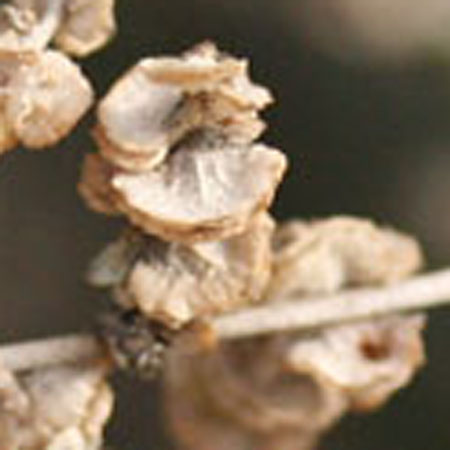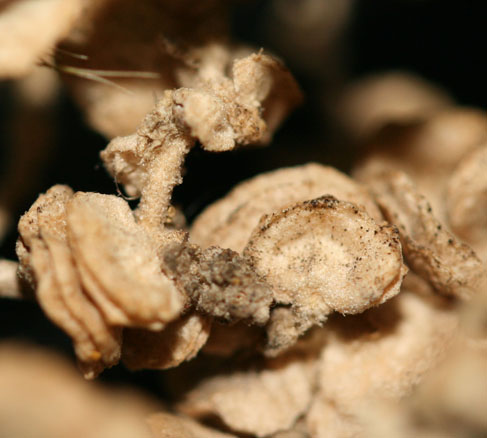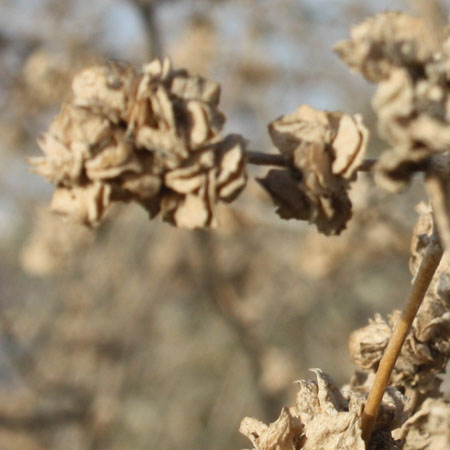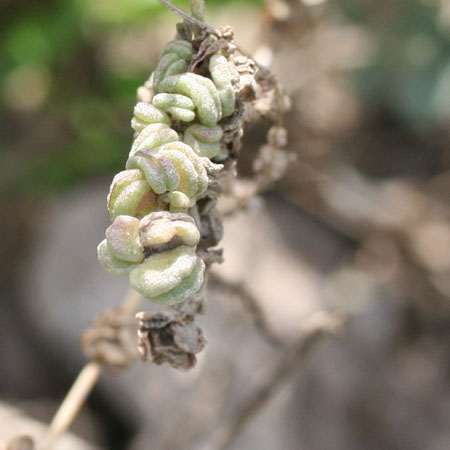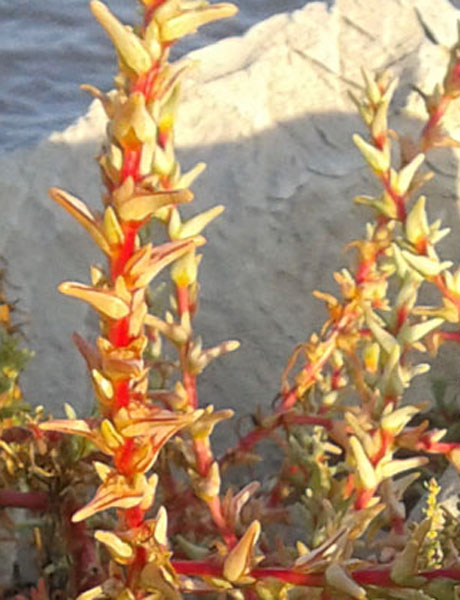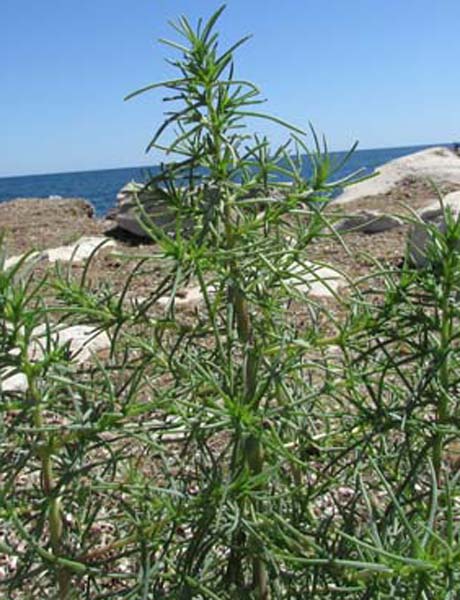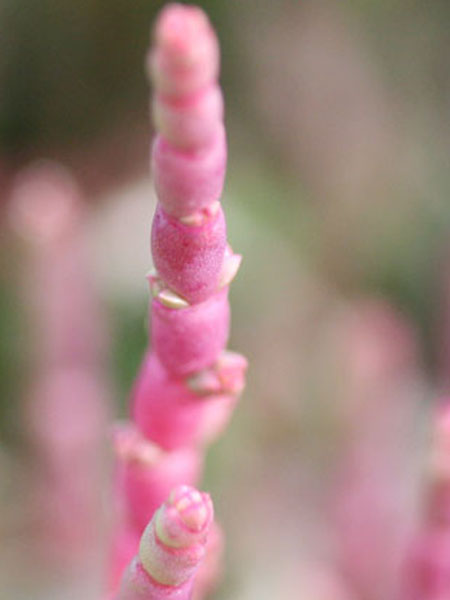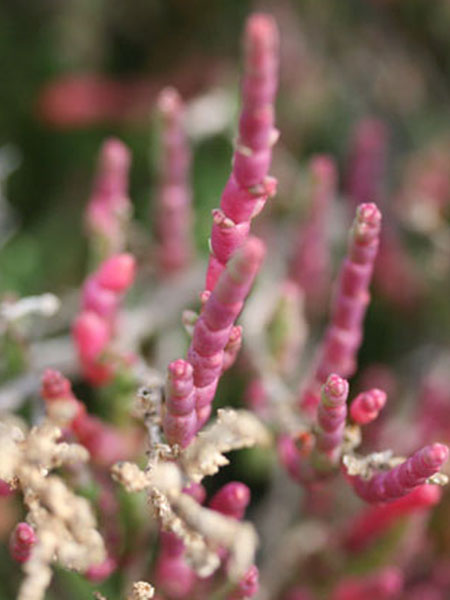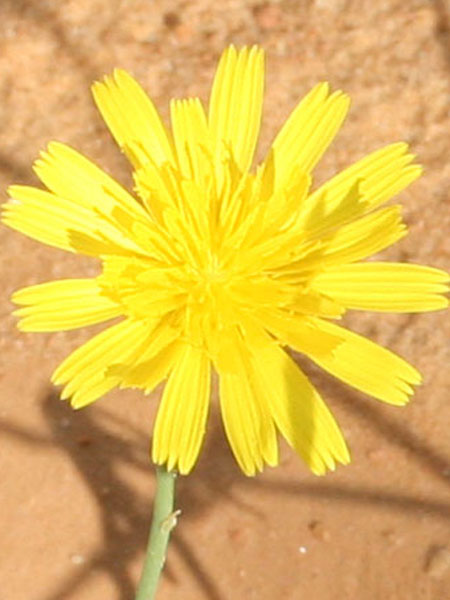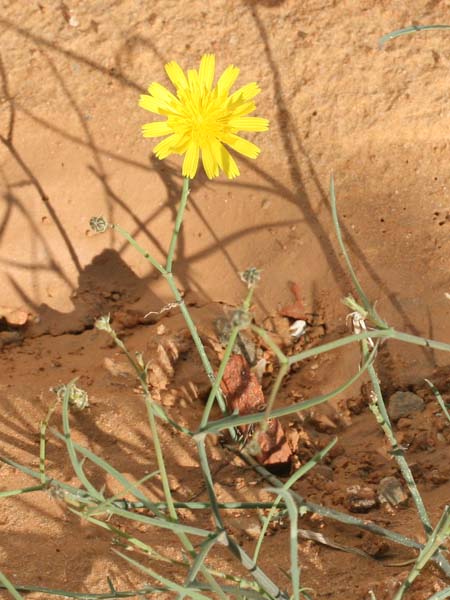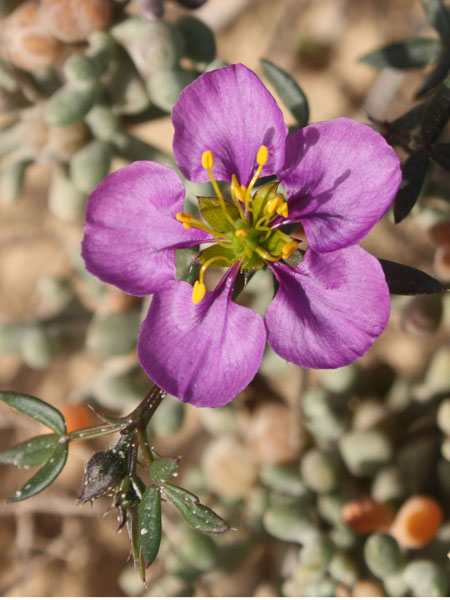Atriplex halimus
Kingdom : Plantae / النّباتات
Division : Spermaphyta / البذريات
Clade : Magnoliophyta or Angiospermae / مستورات البذور
Class : Eudicotyledoneae / ذات الفلقتين
Order : Caryophyllales / رتبة القرنفليات
Family : Amaranthaceae [Chenopodiaceae] /فصيلة السّرمقيات أوالرّمراميّة أو القطيفيّة
Genus : Atriplex
species : halimus
Chromosomes: 2n=18
Protologue
L. Sp. Pl., ed.1, 1052 (1753)
Common names
Tunisia Arabic English French Tamazight
قطف
قطف ملحي
Saltbush saltbush
Sea orache
Shrubby orache
Arroche halime
Pourpier de mer
Arroche marine
Epinard de mer
Guetaf
Toxic
no
Edible
yes
Latex
no
Botanic description
Genus description
"Monoecious or polygamous plants. Perigon herbaceous, with 3-5 divisions in male flowers and hermaphrodite and with 2 opposite valves in female flowers. Stamens 3-5. Styles 2, filiform welded at the base. Membranous fruit, ovoid, compressed in the 2 accrescent valves of the perigone, bare or provided with dorsal appendages. Vertical seed in the horizontal female flowers in hermaphrodite, lenticular, black or brown flowers.
Species description
"
Large, very stony dioecious shrub with silvery and persistent white foliage, bushy with irregular habit up to 3 meters in height. .
Stems trained twigs Leaves alternate, briefly petiolate; sometimes large reaching 5-6 cm, sometimes very small, very polymorphous: sometimes orbicular, ovate or lanceolate, sometimes deltoid, hasty or rhomboidal, generally whole, with obtuse apex, rarely toothed, somewhat fleshy. Flowers very small hidden between the bracts, in tiny glomerulus tiny yellow, unisexual. Inflorescence terminal steep parnicle. bare or slightly foliage at the base, 20-50 cm long, composed of dense ears of yellowish flowers. Fruits hardy fruiting valves, usually kidney-shaped, with very smooth edges, smooth on the back. Seeds red color
Botanic References
Pottier-Alapetite G. (1981). Flore de la Tunisie Angiospermes –Dicotylédones (Apétales- Dialypétale , Première partie). Imprimerie Officielle de la République Tunisienne (Eds), 54 p. Edouard LE FLOC’H, Loutfy BOULOS et Errol VELA. (2010). Catalogue synonymique commenté de la FLORE DE TUNISIE. République Tunisienne, Ministère de l’Environnement et du développement durable, Banque Nationale de Gènes. 500 p www.theplantlist.org
Biology
Life form Perennial Type form Nanophanerophyte Photosynthesis C4
Phenology
Blooming
JanuaryFebruaryMarchAprilMayJuneJulyAugustSeptemberOctoberNovemberDecember
Fruiting
JanuaryFebruaryMarchAprilMayJuneJulyAugustSeptemberOctoberNovemberDecember
Map Localization
Ecology
Adaptation It is a species of the littoral and sebkhas. It requires little maintenance, adapts to poor land and is resistant to salt spray. Salt bladder yes Invasive no
Geographical distribution
Localization Biocimatic stage Annuel pluviometry (mm) GPS Monastir (Sahline (Janv.2014));(Skhanès (Déc.2013; Juillet 2016));(Sidi Ghedamssi (Fév.2016)) Inferior semi-arid 331 35°46'8.35"N/10°42'42.48"E 35°46'42.03"N/10°47'39.47"E 35°46'56.11"N/10°49'59.82"E Sousse (Nefidha, Déc. 2013) Inferior semi-arid 354 36° 1'9.63"N 10°25'35.44"E
General uses
It is cultivated for the ornamentation of the edges of the roads, green spaces and gardens. It forms protective hedges in the seaside gardens. It is appetized by all herbivores especially goats and dromedaries. It is consumed by seabirds because its leaves are rich in nutrients and used as man food at times of severe famine: to prepare special couscous, "bethboutha" in Gafsa and "mesfouf" in Mednine where it was said that "the one who has the" Gtaf "will never starve". The seeds were harvested, crushed with wood mortar and eaten in slabs or boiled.
Medicinal uses
"The plant treats inflammations and it is used to heal wounds. It is used in decoction against cold, intestinal worms, cardiac arrhythmia.
NOTE : This website is not that of herbal medicine and assumes no responsibility for the negative effects of the use of plants. Seek advice from a professional before using a medicinal plant.
Systems / Organs / Effects
Digestive System Respiratory System Hypolipedemic Hypoglycemic
Description of the seeds
Form lenticular External structure any Ornamentation any Type of seed albumen Average length of 10 seeds 2.3 ± 0,1 (mm) Average width of 10 seeds 1.3 ± 0,1 (mm) Average thickness of 10 seeds 0.1 ± 0,01 (mm) Average mass of 100 seeds (g)
Test results
TPC DPPH ABTS+ FRAP Year mg GAE g-1 MS CI50 g ml-1 CI50 g ml-1 CE50 g ml-1 7,54± 0,24 379,22± 20,49 519,62± 6,29 761,55± 18,87 2016 Total Phenols content(TPC), Anti-radical potentialities against (DPPH, ABTS), Ferric reducing antioxidant power(FRAP)
Molecules : ADN / Proteins
Chromosomes : 18 Uniprot NCBI
Chemical composition
Name Terpene Essentiel oils
Phenolic acids Sinapic acid link
Phenolic compounds Coumarine link
Polyphenols
Flavonoïdes
Isorhamnetin link
Kaempferol link
Patuletin link
Quercetine link
Spinacetin link
Tannins link
Tricin link
Other compouds Alkaloides
Protein
Saponin
Vitamins Vitamin A
Vitamin C link
Vitamin D
Tunisian references
Bendaly A, Messedi D, Smaoui A, Ksouri R, Bouchereau A and Abdelly C (2016). Physiological and leaf metabolome changes in the xerohalophyte species Atriplex halimus induced by salinity. Plant Physiology and Biochemistry. 103, 208-218. Chaieb M et Boukhris M (1998). Flore succinte et illustrée des zones arides et sahariennes de Tunisie. Association pour la protection de la nature et de l’environnement, Sfax. 187 p. Debez, A., W. Chaibi and S. Bouzid (2001). Effect of NaCl and growth regulators on germination of Atriplex halimus L. Cahiers Agricultures. 10, 2, 135-138. Smaoui, A., Z. Barhoumi, M. Rabhi and C. Abdelly (2011). Localization of potential ion transport pathways in vesicular trichome cells of Atriplex halimus L. Protoplasma. 248, 2, 363-372.
Other references
Abd El-Rahman HH, Mohamed MI, Gehad AEA, Awadallah IM (2006). Ameliorating the Anti-nutritional factors effect in Atriplex halimus on sheep and goats by ensiling or polyethylene glycol supplementation. Int. J. Agr Biol, 8 (6): 766–769. Alla MMN, Khedr AHA, Serag MM, Abu-Alnaga AZ and Nada RM (2012). Regulation of metabolomics in Atriplex halimus growth under salt and drought stress. Plant Growth Regulation. 67, 3, 281-304. Andres IM (1989). Leaf anatomy of plants from costal mediterranean salt marshes dicotyledons. Candollea. 44, 2, 435-452. Aouissat M, Belkhoja M, Hcini K, Walker DJ and Correal E (2009). Estimation of nuclear DNA content in Algerian populations of Atriplex halimus and Atriplex canescens by flow cytometry. Anales de Biologia. 31, 15-18. Aronson JA, D Pasternak and A Danon (1988). Introduction and first evaluation of 120 halophytes under seawater irrigation. In: Arid lands : today and tomorrow : proceedings of an international research and development conference, Tucson, Arizona, U.S.A., October 20-25, 1985. 737. -746. Bajji M, Kinet JM and Lutts S (1998). Salt stress effects on roots and leaves of Atriplex halimus L. and their corresponding callus cultures. Plant Science. 137, 2, 131-142. Bajji M, JM Kinet and S Lutts (2002). Osmotic and ionic effects of NaCl on germination, early seedling growth, and ion content of Atriplex halimus (Chenopodiaceae). Canadian Journal of Botany-Revue Canadienne De Botanique. 80, 3, 297-304. Barness G, Zaragoza S, Shmueli I and Steinberger Y (2009). Vertical Distribution of a Soil Microbial Community as Affected by Plant Ecophysiological Adaptation in a Desert System. Microbial Ecology. 57, 1, 36-49. Belkheiri O and M Mulas (2013). The effects of salt stress on growth, water relations and ion accumulation in two halophyte Atriplex species. Environmental and Experimental Botany. 86, 17-28. Benhammou N, Atik Bekkara F, Kadifkova Panovska T (2009). Antioxidant activity of methanolic extracts and some bioactive compounds of Atriplex halimus. C. R. Chimie, 12: 1259–1266. Blumenthal-Goldschmidt S and Poljakof-Mayber A (1968). Effect of substrate salinity on growth and on submicroscopic structure of leaf cells of Atriplex halimus L. Australian Journal of Botany. 16, 3, 469-479. Bouchenak F, Henri P, Benrebiha FZ and Rey P (2012). Differential responses to salinity of two Atriplex halimus populations in relation to organic solutes and antioxidant systems involving thiol reductases.Journal of Plant Physiology. 169, 15, 1445-1453. Bylka W (2004). A new acylated flavonol diglycoside from Atriplex littoralis. Acta. Physiol Plant, 26(4): 393-398. Bylka W, Stobiecki M, Frahski R (2001). Sulphated flavonoid glycosides from leaves of Atriplex hortensis. Acta Physiol. Plant, 23 (3): 285-290.
El Ferchichi OH, H’cini K, Bouzid S (2006). Chromosome number in Tunisia populations of Atriplex halimus L. (Chenopodiaceae). Afr. J. Biotechnol. 5 : 1190-1193.Fernandez-Illescas F, FJJ Nieva, B Marquez-Garcia and AF Munoz-Rodriguez (2010). Pollen production in halophytic species of the Chenopodiaceae in a Mediterranean marsh. Grana. 49, 4, 300-307.
Food and Agriculture Organization (1971). Les Atriplex en Tunisie et en Afrique du Nord. Rapport Technique 7.Ghaffari, S. M., Z. Balaei, T. Chatrenoor and H. Akhani (2015). Cytology of SW Asian Chenopodiaceae: new data from Iran and a review of previous records and correlations with life forms and C-4 photosynthesis. Plant Systematics and Evolution. 301, 2, 501-521. Grafe, M; Klauber, C (2011). Bauxite residue issues: IV. Old obstacles and new pathways for in situ residue bioremediation. HYDROMETALLURGY. 108, 1-2, 46. -59. Haddi ML, S Filacorda, K Meniai, F Rollin and P Susmel (2003). In vitro fermentation kinetics of some halophyte shrubs sampled at three stages of maturity. Animal Feed Science and Technology. 104, 1-4, 215-225. Khaldi A, Amamra D, Tir touil A, Maghdouri N,Belhadj N (2015). Effects of Atriplex Halimus on Resistant Bacterial Strain of Different Origins International Conference on Advances in Agricultural, Biological & Environmental Sciences (AABES-2015) July 22-23. Kheiria H, DJ Walker, E Correal and S Bouzid (2008). Estimation of nuclear DNA content in populations of Atriplex halimus L. (Chenopodiaceae) by flow cytometry. Caryologia. 61, 2, 160-163. Le Houerou HN (1980). Browse in Africa - the current state of knowledge. Le Houerou HN (1986). Salt tolerant plants of economic value in the mediterranean basin. Reclamation & Revegetation Research. 5, 1-3, 319. -341. Lutts S and I Lefevre (2015). How can we take advantage of halophyte properties to cope with heavy metal toxicity in salt-affected areas?. Annals of Botany. 115, 3, 509-528. Manousaki E and N Kalogerakis (2009). Phytoextraction of Pb and Cd by the Mediterranean saltbush (Atriplex halimus L.): metal uptake in relation to salinity. Environmental Science and Pollution Research. 16, 7, 844-854. Melone L, GS Valenti and G Dondero (1988). Atriplex-halimus l. Some germination features in relation to the seed polymorphism and to the medium salinity.Bollettino Societa Italiana Biologia Sperimentale. 64, 10, 877-884. Miloud A, M Belkhoja, K Hcini, DJ Walker, E Correal (2009). Estimation of nuclear DNA content in Algerian populations of Atriplex halimus and Atriplex canescens by flow cytometry Anales de Biologia 31: 15-18. Mirsky et Nitsa (2001). Naturally extracted and synthetic hypoglycemic or hypolipidemic compositions. Application N°. US 09/842971. http:// www. freepatentsonline.com. Mozafar A and JR Goodin (1970). Vesiculated Hairs: A Mechanism for Salt Tolerance in Atriplex halimus L.. Plant Physiology. 45, 62-65. Mozafar A, JR Goodin and JJ Oertli (1970). Sodium and potassium Interactions in increasing the salt tolerance of Atriplex halimus L. : II. Na+ and K+ uptake characteristics. Agronomy Journal. 62, 481-484. Munoz-Rodriguez AF, P Rodriguez-Rubio, FJJ Nieva, F Fernandez-Illescas, E Sanchez-Gullon, JM Soto, V Hermoso-Lopez and B Marquez-Garcia (2012). the importance of bracteoles in ensuring atriplex halimus germination under optimal conditions. Fresenius Environmental Bulletin. 21, 11C, 3521-3526.
Nada RM and GM Abogadallah (2015). Developmental acquisition of salt tolerance in the halophyte Atriplex halimus L. is related to differential regulation of salt inducible genes. Plant Growth Regulation. 75, 1, 165-178.Ortiz-Dorda J, C Martinez-Mora, E Correal, B Simon and JL Cenis (2005). Genetic structure of Atriplex halimus populations in the Mediterranean Basin. Annals of Botany. 95, 5, 827-834. - Osmond CB, O Bjorkman , DJ Anderson (1980). Physiological processes in plant ecology: toward a synthesis with Atriplex. Vol 36. Parraga-Aguado I, MN Gonzalez-Alcaraz, J Alvarez-Rogel and HM Conesa (2014). Assessment of the employment of halophyte plant species for the phytomanagement of mine tailings in semiarid areas. Ecological Engineering. 71, 598-604. Pyankov VI, Ziegler H, Akhani H, Deigele C, Luttge U (2010). European plants with C-4 photosynthesis: geographical and taxonomic distribution and relations to climate parameters. BOTANICAL JOURNAL OF THE LINNEAN SOCIETY. 163, 3, 283. -304. Qasem Jamal R (2015). Prospects of wild medicinal and industrial plants of saline habitats in the jordan valley. 47, 2, 551. -570. Rachida K, A Merzouk S, M Hassiba and B Noury (2015). Germination of Atriplex halimus Linnaeus, 1753 (Caryophyllales Chenopodiaceae) in North West Algeria. Biodiversity Journal. 6, 2, 663-668. Salama FM, SM El-Naggar and T. Ramadan (1999) Salt glands of some halophytes in Egypt. Phyton-Annales Rei Botanicae. 39, 1, 91-105.


























